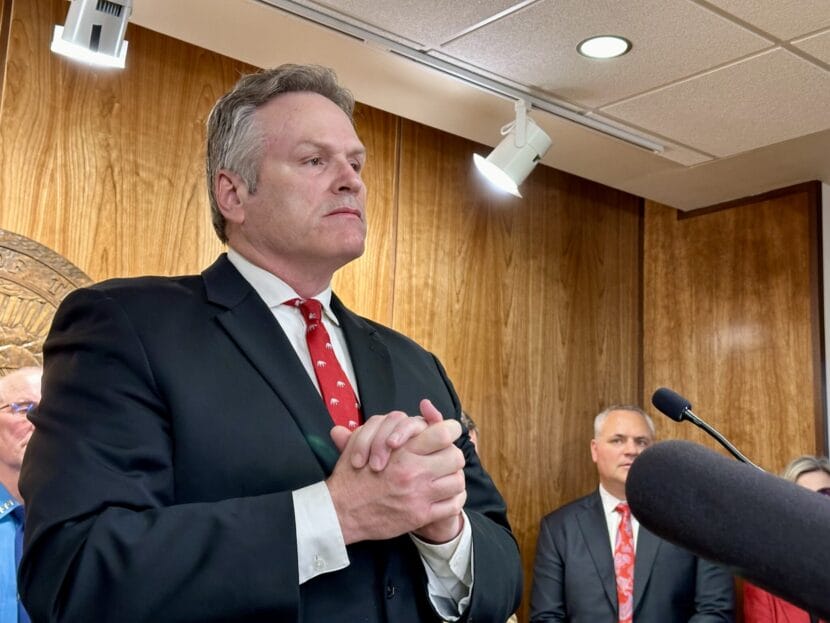
Gov. Mike Dunleavy announced a $10.5 billion budget for the next fiscal year on Thursday. The spending plan includes a large permanent fund dividend but relies on savings to fill a deficit estimated to reach nearly $1 billion.
The budget covers Fiscal Year 2025, which runs from July 2024 through the following June. The Republican governor’s plan offers a starting point for negotiations with lawmakers as they craft the state’s final budget during next year’s legislative session.
The biggest single expense would be $2.3 billion for permanent fund dividends. Dunleavy said the amount was in line with a 1980s-era law outlining a formula for the PFD.
“The reason for that is it’s in statute. I swear to uphold the Constitution and the statutes in the state of Alaska. We understand that the courts ruled years ago that the Legislature may change that,” Dunleavy said. “We look forward to that discussion.”
Dunleavy pitched the large PFDs as a way to help Alaskans keep up with inflation.
The budget does not include an increase in per-student funding to school districts, nor does it include an extension of the one-time education funding lawmakers added to last year’s budget.
But Dunleavy said he was willing to negotiate with lawmakers on education funding.
“As a former educator, I understand that schools cost money, education costs money. There’s no doubt about it,” Dunleavy said. “The question has always been whether we put money into BSA – and that’s the base student allocation, that’s part of the formula for funding – or whether we put money into the education world, in various forms and various, for various purposes.”
As an example, Dunleavy pointed to a proposal he put forward last year that would provide annual retention bonuses of up to $15,000 for teachers.
Anchorage School District Superintendent Jharett Bryant said in a statement he was “disappointed in the lack of emphasis placed on education funding.”
But worry not, says Sen. Bert Stedman, the co-chair of the powerful Senate Finance Committee focused on the state’s operating budget. Stedman, a Republican from Sitka, said in a phone interview he expects the governor to offer more in his amended budget, which is due by mid-February.
“The school funding is, I think, artificially low in the budget,” Stedman said. “I would suggest that the superintendents use last year’s funding numbers, and we’ll work through that process after the governor has done with his amendments in February.”
With oil prices forecast to come in above earlier estimates, and production projected to be down slightly, Stedman said he expects the final budget passed by the Legislature to closely resemble the version ultimately signed into law after last year’s session.
Senate President Gary Stevens said he was concerned the governor’s proposal to issue roughly $3,300-per-person permanent fund dividends would draw too heavily on savings.
Though the governor says his proposal would pull $987 million from the state’s Constitutional and Statutory Budget Reserve accounts, the Kodiak Republican said he expects the deficit to come in closer to $1.5 billion once everything is all said and done.
“That is just too much to draw out,” Stevens said. “You know, we have to have some monies there if things go to hell in a handbasket, say in the oil industry, and we’ve got to have enough money to run government. So that’s simply too much to take out of the Constitutional Budget Reserve.”
A spokesperson for Republican House Speaker Cathy Tilton of Wasilla declined an interview request, saying her caucus is still working through the budget.
Dunleavy’s proposal includes enough money to run seven Alaska Marine Highway ferries, according to his transportation commissioner, Ryan Anderson. Four are currently in service. Anderson said short-staffing continues to make it difficult to actually bring all of the available ships online.
The budget also includes roughly $23 million in state funding for a replacement for the state ferry Tustumena. The money would help unlock another $92 million in federal grants.
The governor’s budget serves as a statement of political priorities – an opportunity for the governor to tell legislators and the public what he believes the state should spend its money on. But it’s on lawmakers to craft a budget bill that can make it through a closely-divided, Republican-led House and a bipartisan-majority Senate. The legislative session starts Jan. 16.